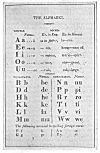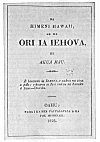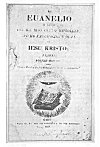
Sacred Texts Pacific Index Previous Next

FOREIGNERS from all over the world called on the Hawaiians and remained with them forty years before the missionaries came. Their influence was negative. They did not study the people or help them to study. John Young, Don Marin and Isaac Davis were notable exceptions in a few things, but the fact remains that no earnest effort was made by any one to help the natives intellectually until the missionaries came.
Alexander Campbell, who, in 1809, was left in Honolulu by a whaling ship on account of frozen feet, revealed the situation. The king Tamaahmaah (Ka-meha-meha) ordered Boyd, his carpenter, to make a loom for Campbell to use in weaving cloth for sails. Boyd declined, saying, "The natives should be taught nothing that would render them independent of strangers."
Campbell places on record the feeling among the foreigners. "When a brother of the Queen's, whose name I do not remember--but who was usually called by the white people John Adams--wished me to teach him to read, Davis would not permit
me, observing, 'They will soon know more than ourselves.'" It is interesting to note that Gov. Adams, whose native name was Kuakini, did learn to read and write under the missionaries and has left two short letters, in both of which he presents a request for saws.
In one he says, "My wife is going away to Hawaii. If perhaps she can carry, give you to me sahs tools," signed "Gov. Adams." In the other letter he says he is building a house and wants a "sah tool" which he will return when the work is done.
The missionaries landed at Kailua on the island Hawaii, April 4, 1820, and there divided their party, the larger number coming to "Hanaroorah, Honolulu, April 19."
Mr. Bingham says, "They began at once to teach.--The first pupils were the chiefs and their favourite attendants and the wives and children of foreigners." The first instruction was necessarily in English, but the missionaries used every opportunity to become acquainted with the speech of the people and make it a written language. They wrote down as carefully as they could every new word which came to their ears. This was no small task and was absolutely necessary as the foundation of a written language.
As soon as the missionaries were sure of the orthography and pronunciation of a number of words they prepared a primer or spelling book to be

Click to enlarge
FIRST LEAFLET PRINTED, 1822
printed for the schools they were carrying on. Mr. Bingham says : "On the 7th of January, 1822, we commenced printing the language in order to give them letters, libraries and the living oracles in their own tongue. A considerable number was present, and among those particularly interested was Ke-au-moku (Gov. Cox) who after a little instruction by Mr. Loomis applied the strength of his athletic arm to the lever of a Ramage press, pleased thus to assist in working off a few impressions of the first lessons."
Although these impressions were merely proof sheets, probably, of the first half of the spelling book, yet the large number printed and put in use, nearly 100 in all, would make this the first item printed.
This was the first printing done in the Hawaiian islands and along the North Pacific coast west of the Rocky Mountains. These first sheets created a new interest among the chiefs. King Liho-liho (Ka-meha-meha II) visited the press, saw a sheet of clean white paper laid over the type, then "pulled the lever around and was surprised to see the paper instantly covered with words in his own language."
While the chiefs were awakened by these proof impressions to intellectual desires never before experienced, the work was being pushed of finishing the second "signature" and the complete book of sixteen pages was printed in an edition of 500 copies. Gov. Adams (Kuakini) secured one of the
first copies of these lessons "and was quickly master of them."
Liho-liho was glad to have the chiefs instructed and took 100 copies of the first primer for his friends and attendants. Ka-ahu-manu took 40 for her friends. These probably came from this printing of 500 copies. In the latter part of September, another printing of 2,000 copies was made from the same type.
Liho-liho felt a little like the foreigners who did not want the natives instructed. He wanted the education reserved for the chiefs because, according to Mr. Bingham, "he would not have the instruction of the people in general come in the way of their cutting sandalwood to pay his debts."
Nevertheless, the flood could not be held back and the privilege of reading and writing rapidly spread among the people. In six years there was the record--
"Oahu: Mission Press, Nov. 1828; 5 Ed.; 20,000. Total, 120,000."
Meanwhile a great deal of other printed matter had been issued from that first press.
March 9, 1822, at the request of the king and high chiefs a handbill, entitled, "Port Regulations," was printed, probably to aid the rulers in quieting the differences which were continually arising with sea captains. The fourth item recorded as issued in these islands was in December, 1823, and is the very rare and unique little book of 60 pages of

Click to enlarge
TITLE PAGE OF FIRST HYMN BOOK, 1823
[paragraph continues] Hawaiian hymns prepared by Rev. Hiram Bingham and Rev. William Ellis, an English missionary from Tahiti who resided in Honolulu at the time, heartily allying himself with the American missionaries. His previous knowledge of the similar language of Tahiti made it easy for him to learn Hawaiian. The edition of this hymn book was 2,000 copies.
The most interesting part of the story of printing in the Hawaiian Islands belongs to the greatest work accomplished for the good of the people--the printing of the Bible in the Hawaiian language. This article has space for only a few facts. The first printed Bible passage was in a revised spelling book published April, 1825. This was John 3, 16-21. Then in June, 1825, a booklet, 4 pages, called--"He olelo a ke Akua," or "Selected Scriptures," was probably printed on the same demy with "He ui," or "A catechism," 8 pages--each 7,000 copies. In November, 1825, the hundredth Psalm was "printed on a card for the opening of the church built by Ka-lai-moku at Honolulu," then in December, 1825, the Ten Commandments and the Lord's Prayer; in July, 1826, the Good Samaritan, and in January, 1827, the Sermon on the Mount.
In December, 1827, came the first systematic attempt toward printing the Bible. Twelve pages of the Gospel of Luke were struck off--10,700 copies. Later the entire book of Luke was printed in Honolulu.
[paragraph continues] The other gospels, Matthew, Mark and John, were printed in 1828 in the United States. A copy of these three gospels, bound in an elegant and substantial cover, was presented to Ka-pio-lani, the high chiefess who defied Pele on the brink of the pit-crater of Kilauea in 1825. This volume now lies in the archives of the Hawaiian Board. The entire Bible was completed and "the finishing sheet was struck off May 10, 1839."
An interesting prophecy concerning the completion of the Bible is found in a writing book, where, under the date April 30, 1827, is the record of a conversation. Mr. Bingham says that it is the duty of the mission to complete a translation of the Bible in five years from this time and thinks that with circumstances as favourable as they now are it will be done.
Mr. Whitney says: "I say if the whole Bible is in print in the Hawaiian language in ten years from this time it is as much as I expect, and I think will be a progress exceeding that of any other mission to any heathen country having a language not previously written or reduced to order." It was a little over twelve years after the first pages were prepared before the complete Bible was in print.

Click to enlarge
FIRST BIBLE PRINTING, 1827
GOSPEL OF LUKE